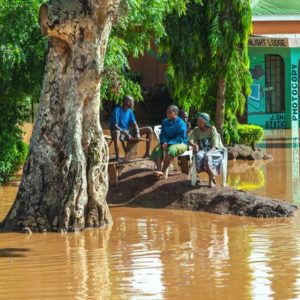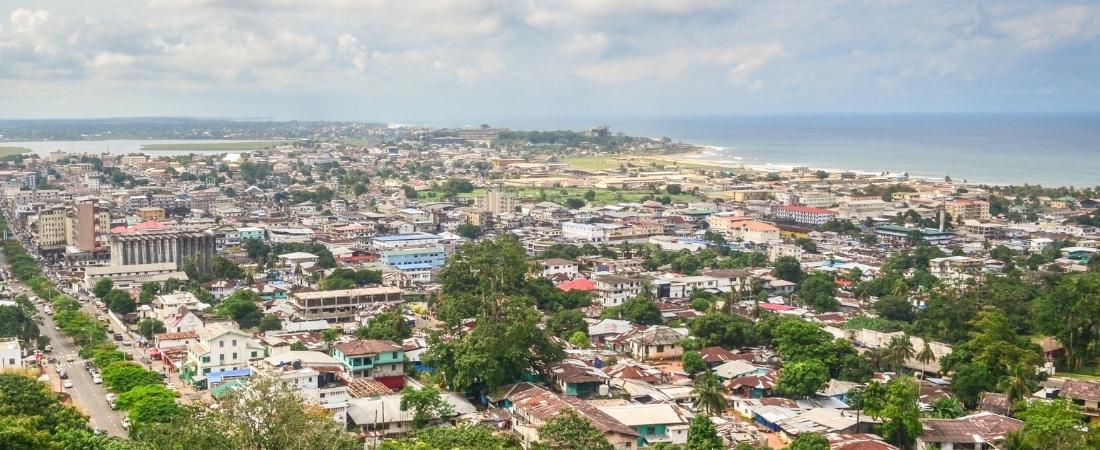PHOTO: Aerial view of Monrovia, Photo UNDP Liberia 2020
Renamed Monrovia in 1822, Liberia’s capital city which was built by freed slaves and returnees from the Congo Basin has become visibly vulnerable to climate change influences. Yet, despite being considerably impacted by climate change, the city lacks an action to tackle the problem, our findings show.
According to USAID, sea-level rise (SLR) and the increasing frequency of high-intensity storms, both of which contribute to coastal erosion and shoreline retreat, are causing hardship for those living in coastal Monrovia, with displacements resulting from violent sea erosion and flooding each year.
Waste management is a daunting task for the Monrovia City Corporation (MCC), so much that stockpiles of garbage are found nearly everywhere.
All vehicles plying the streets are either diesel or gasoline fed, emitting enormous amounts of greenhouse gases in the air every day.
While urban settlements across the country produce varying amounts of greenhouse gas effects, Monrovia’s emission alone stands out largely owing to the overpopulation as a result of the centralization of nearly all basic social services in the small city.
Behind these scary scenarios of climate change, yet, one of the biggest challenges the human race is faced with today, lies sad news- Monrovia has no plan to tackle climate change.
West Point, New Kru Town, Almost Gone to Sea Erosion
A densely populated slum township of Monrovia is situated on a 0.53 km square peninsula that empties into the Atlantic Ocean right between the Mesurado and St Paul Rivers in Montserrado County is ‘West Point’.
It is divided into six zones, the settlement of more than 40 thousand residents occupied by Kru and Fanti fishermen faces disturbing environmental degradation each day with more than forty 40% of its land size already eroding into the Atlantic Ocean, according to community dwellers.
Joseph Kruah, a resident who has lived there for twenty-six (26) years of his life was forced to relocate by midnight on August 17, 2018, as seawater intruded his home to wet the bed on which he, his wife, and two children were sleeping.
“The sea has been coming to us for years but the government did nothing to stop it and so that night we nearly died,” Kruah lamented.
The wife, a fish seller in Monrovia’s Nancy Doe Market added that “nothing” has been done to put an end to the continuous sea encroachment.
Not only is West Point confronted with a sea erosion crisis, but endemic problems including overpopulation, robbery, and diseases such as tuberculosis, malaria, and other water-borne diseases and crimes.
A famous New Kru Town settlement, another densely populated community is also under intense pressure from sea erosion, with calls for past and present governments to take action to save the highly acclaimed D-Tweah High School.
From Mamba Point to Thinker Village, and the Roberts Field Highway, sea erosion has visible prints everywhere, thus posing grave challenges for residents and business entities in those areas.
According to a report by Reuters News Agency, “rising sea levels and erosion have destroyed about 800 homes and displaced more than 6,500 people” around Monrovia since 2013 alone.
Transportation-related emission and power sources
Liberia’s transport sector is hugely dependent on diesel and gasoline-powered vehicles.
Cars, Tricycles, and motorbikes that move people in and around Monrovia do so squarely on fuel consumption.
Across the world, it is estimated that vehicles with fuel engines contribute about 1.6 billion tons of greenhouse gases (GHGs) into the atmosphere each year—mostly in the form of carbon dioxide (CO2) contributing to global climate change.
With estimates that each gallon of gasoline you burn creates 20 pounds of GHGs, one can imagine how much emission Monrovia, a city-run almost entirely on fuel, could be sent into the atmosphere.
Like many African Countries in nearly all of Sub-Saharan Africa, biomass which includes (firewood, charcoal, and crop residues) is the primary energy source used for domestic cooking and heating.
Over 99.5% of Monrovia’s residents, many of them poor people living in slum communities, depend on biomass-based fuels, according to the United Nations Development Program (UNDP).
As of 2019, Liberia’s Carbon dioxide emissions from the burning of fossil fuels for energy and cement production with land-use change not included stands at 1.32million tons compared to 761,153 tons in 2010. To many of the population, these things mean nothing.
Waste Management is a daunting task for Monrovia Authorities
Monrovia’s population has increased over the years accompanied by fast urbanization, economic advancement, higher cost of living standards, and changes in consumption patterns and lifestyles increasing waste all across the city.
The downright mismanagement of solid waste across Monrovia and its environs tends to pose a serious threat to the city’s environmental sustainability.
It seems that the Monrovia City Corporation (MCC) is missing out on the key ingredients of waste management which are to ensure a healthy environment by addressing concerns related to environmentally friendly disposal of waste. The Municipal Government of Monrovia seems to be failing to create a healthier environment through the proper collection, storage, transfer, recovery, recycling, treatment, and disposal of waste.
Martha Weah, 54, lives on Center Street in Monrovia but says she is fed up with the inability of MCC to collect waste over the years.
“You see this place right by the graveyard, MCC will take weeks to collect the dirt,” Madam asserted.
She told the author of this article that rats, insects, and terrible smells have now become a way of living, and “I have committed myself to relocate in the next one month.”
MCC’s Lack of Climate Vision

Construction in swamps and waterways often leads to flooding in Monrovia and parts adjacent (photo Shutterstock)
The Monrovia City Government’s head of Environment Management-Sayetta Doman Kpadeh admits that there are no climate plans but argues that the city is developing one.
True to her words, the MCC website carries zero information on any climate-related plan even though its head of environment says works are in progress to develop one.
“We started planting trees in various communities in Sinkor, Somalia Drive, and even engaged in building defense at the back of the new Kru Town D-Tweh High School,” Kpadeh said.
She however admits the city is already faced with the creeping impacts of climate change mentioning “rising sea levels and flooding as major concerns.
Partners and donors she said “are working with us to address challenges with drainage, improve roads, water supply, and markets across the city, but was quick to mention that “management of solid waste is not easy and requires a lot of funding,” blaming Monrovia’s massive waste headache on “breakdown of equipment, shortage of fuel supply and behavior change”.
The United Nations says “cities around the world are the main cause of climate change but can also offer a part of the solution to reducing the harmful greenhouse gases that are causing global temperatures to rise”.
According to UN-Habitat Executive Director Maimunah Mohd Sharif, “over half of the world’s population lives in cities, and this is likely to increase to over two thirds by 2030 with the use of a large proportion of the world’s energy supply and are responsible for around 70 percent of global energy-related greenhouse gas emissions which trap heat and result in the warming of Earth”.
While cities like Accra, Lagos, Banjul, Conakry have been able to develop at least some form of climate plan or actions aimed at achieving adaptation and mitigation, Monrovia, one of Africa’s oldest capitals, is still lagging. The City has been unable to develop a roadmap for tackling the climate crisis.

The Monrovia City Government’s head of Environment Management-Sayetta Doman Kpadeh
With this lack of climate change plan by Monrovia leadership, it is not clear how the Environmental Protection Agency intends to roll out aspirations in its Nationally Determined Contribution (NDC) and an ambitious Climate Change Policy and Response Strategy which the EPA launched in late 2018.
On Tuesday, US President Joe Biden in his first address to the UN General Assembly called on UN member states to work together to tackle climate change which he described as critical.
Note: This story was produced under the NAREP Climate Change Media 2021 fellowship of the Premium Times Centre for Investigative Journalism.

